
News |
- ME3 Is Now Fresh Energy
- International Fish Stocks on Brink of Extinction
- Bottled Water No Friend of Environment
- Intervener Status for DFO Public Trust Case
- Supreme Court Favours Rivers Over Dams
- Poplar River Launches Plan, Seeks Protection
- New Manitoba Oriented Strand Board Plant
- Company Sues Aboriginal Community for $10 Billion
- International Migratory Bird Day
- Biodiversity Loss Increasing - IUCN
- Wildlands League Releases Boreal 'Portrait'
- Accountability Act Blocks Access to Information
| ME3 Is Now Fresh Energy | 02 June 06 |
 Minnesotans for an Energy-Efficient Economy has transformed environmental and economic ideals into smart government policy for more than 15 years. The organization has moved to a new phase and new name. Minnesotans for an Energy-Efficient Economy has transformed environmental and economic ideals into smart government policy for more than 15 years. The organization has moved to a new phase and new name.The name Fresh Energy better reflects current programming - energy independence, economic prosperity, public health, and environmental protection throughout the US Midwest and beyond. JustEnergy remains a program of Fresh Energy. JustEnergy supports hydro affected communities in northern Manitoba with Ken Bradley of Fresh Energy assisting with many stages of production for the film Green Green Water. The film has been screened for capacity crowds in Winnipeg, Cross Lake, Nelson House, Thompson, and South Indian Lake during April and May 2006. Learn more and join the journey at Fresh Energy Visit the Green Green Water website Source: Fresh Energy, Manitoba Wildlands
|
|
| International Fish Stocks on Brink of Extinction | 29 May 06 |
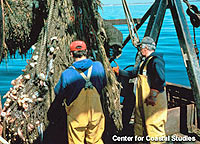 Fish stocks in international waters are being plundered to the point of extinction, according to a new report from WWF and TRAFFIC, the wildlife trade monitoring network. Fish stocks in international waters are being plundered to the point of extinction, according to a new report from WWF and TRAFFIC, the wildlife trade monitoring network.Follow the Leader: Learning from experience and best practice in regional fisheries management organizations illustrates both effective and ineffective practices while also outlining how regional fisheries management organizations (RFMOs) can work smarter and better. Species under severe threat include tuna and the orange roughy. The orange roughy is targeted by bottom-trawlers, which drag heavy rollers over the ocean floor, destroying coral and other ecosystems. The authors are calling on the United Nations to review fishing on the high seas and strengthen the resolve of regional authorities to deal with states that flout agreements. View the May 19, 2006 WWF International press release View the May 19, 2006 BBC News article View the report Follow the Leader: Learning from experience and best practice in regional fisheries management organizations (PDF) Sources: WWF International, BBC News |
|
| Bottled Water No Friend of Environment | 29 May 06 |
 Breaking news on bottled water suggests that it might not be the tall cool drink that ecofriendly, health-conscious consumers seek. Breaking news on bottled water suggests that it might not be the tall cool drink that ecofriendly, health-conscious consumers seek.In the United States - where half of Americans drink bottled water regularly, and one in six avoids the tap entirely - consumers have been convinced that bottled water is a healthy choice, even though the Environmental Protection Agency does a better job of monitoring water from home taps than the Food and Drug Administration does tracking water sold at the grocery store. "Bottled water is getting people into the habit of paying an awful lot more for their drinking water," says Tony Clarke, author of Inside the Bottle, a book-length expose of the industry cited in the January/February 2006 issue of Canadian Dimension. As much, in fact, as 10,000 times what they pay for tap water. In 2003 the world's three largest for-profit water services corporations, France's Suez and Vivendi (now Veolia) and Germany's RWE-Thames, announced their goal to take control of 70 percent of U.S. and Canadian public water utilities within 10 years. Consumers now spend more than $100 billion a year on bottled water, according to the Earth Policy Institute. At the same time, water shortages near bottling plants have been reported everywhere from villages in India to towns in Wisconsin, Texas, New Hampshire, and Florida, as companies extract water to sell elsewhere. View the May/June 2006 Utne Reader article Visit Tony Clarke's book Inside the Bottle web site View the February 2, 2006 Earth Policy Institute Eco-Economy Update on Bottled Water Source: Utne Reader |
|
| Intervener Status for DFO Public Trust Case | 26 May 06 |
 Groups from across Canada represented by Sierra Legal Defence Fund have been granted intervener status as "friends of the court" for a June 13 and 14 2006 hearing in the Prince Edward Island Supreme Court - Appeal Division. Groups from across Canada represented by Sierra Legal Defence Fund have been granted intervener status as "friends of the court" for a June 13 and 14 2006 hearing in the Prince Edward Island Supreme Court - Appeal Division.The PEI Court of Appeal ruled that public interest groups Earth Action of PEI, Ecology Action Centre of Nova Scotia and Living Oceans of British Columbia, can make submissions to the Court, which is hearing the appeal on the public trust and fiduciary obligations of the Government of Canada and the fair and effective administration of the fisheries by the Department of Fisheries and Oceans (DFO). In their appeal of the Supreme Court's decision, the federal government is asking the PEI Court to decide if the province can even bring a law suit alleging the federal government failed to manage the fishery fairly for the equal benefit of all, and whether the court of the province has jurisdiction to hear the case. "In our view, this case is an example of one of the greatest breaches of public trust in Canadian history," says Mark Butler, Marine Coordinator, Ecology Action Centre. "The issue has national importance because the federal Fisheries Act applies across the country," says Dorthea Hangaard of BC's Living Oceans Society. View the May 19, 2006 Sierra Legal Defence Fund press release Source: Sierra Legal Defence Fund |
|
| Supreme Court Favours Rivers Over Dams | 26 May 06 |
 The US Supreme Court sided with the environment in a May 15, 2006 ruling, rejecting the argument of a US power company it did not need state approval to qualify for a federal license because its operations did not add pollutants to the water that passed through its turbines. The US Supreme Court sided with the environment in a May 15, 2006 ruling, rejecting the argument of a US power company it did not need state approval to qualify for a federal license because its operations did not add pollutants to the water that passed through its turbines.The US federal Clean Water Act requires an applicant for a federal license or license renewal to first obtain state certification of its activities that "may result in any discharge into the navigable waters." The court decided to give the word "discharge" its plain, everyday meaning: "flowing or issuing out." The flow of water over a dam is therefore a "discharge". The unanimous court decision holds that states may protect the health of their rivers, even though hydroelectric dams are regulated by the US federal government. The decision applies to about 2,500 hydroelectric dams on 500 rivers in 45 states. The ruling on rivers and dams resolved aconflict in US law. The Federal Power Act says hydro-power dams are to be regulated by federal authorities with the aim of producing electricity. But the Clean Water Act says those who "discharge" anything into a state's navigable waters must obtain a permit from the state. View the May 16, 2006 New York Times article Sources: New York Times, Los Angeles Times |
|
| Poplar River Launches Plan, Seeks Protection | 24 May 06 |
 The 800,000-hectare boreal forest Poplar/Nanowin Rivers protected park reserve, which covers most of the Poplar River First Nation traditional territory is now ready for permanent protection and final designation by Manitoba. The community's lands plan calls for permanent protection from development of over 90% of these lands. Poplar River First Nation's web site now includes the lands protection and management plan, a mini lands plan, and presentation about Poplar River's lands protection and lands management goals. The 800,000-hectare boreal forest Poplar/Nanowin Rivers protected park reserve, which covers most of the Poplar River First Nation traditional territory is now ready for permanent protection and final designation by Manitoba. The community's lands plan calls for permanent protection from development of over 90% of these lands. Poplar River First Nation's web site now includes the lands protection and management plan, a mini lands plan, and presentation about Poplar River's lands protection and lands management goals.Poplar River First Nation, an east side Manitoba community, is also involved in the First Nation lands protection and management accord which has resulted in a protected lands initiative for a 4 million hectare boreal forest World Heritage Site, posted its lands management plan publicly this week. The Natural Resources Defense Council (NRDC), of Washington DC just launched a new Save Biogems take action in support of the Poplar River First Nation request to Manitoba for permanent protection for these boreal lands. Previous NRDC take action in support of protected lands and this future boreal World Heritage Site have resulted in tens of thousands of letters to Manitoba's Conservation Minster, Stan Struthers and Premier, Gary Doer. Visit the Poplar River First Nation web site  Send an NRDC Biogems take action letter Send an NRDC Biogems take action letterView the Manitoba Wildlands page about the World Heritage Site View the May 25, 2006 NRDC letter to the Manitoba Government (DOC) Sources: Poplar River First Nation, Manitoba Wildlands |
|
| New Manitoba Oriented Strand Board Plant | 24 May 06 |
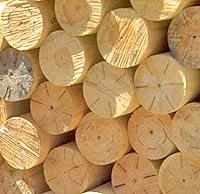 The Vancouver-based Ainsworth Lumber Co. has committed to building a new $250-million oriented strand board (OSB) plant northeast of Winnipeg, which will produce a plywood-like product mainly used in home building for roofing, walls and floors. Ainsworth is the fourth largest producer of OSB in North America with plants in Minnesota, Alberta, British Columbia and Ontario. The Vancouver-based Ainsworth Lumber Co. has committed to building a new $250-million oriented strand board (OSB) plant northeast of Winnipeg, which will produce a plywood-like product mainly used in home building for roofing, walls and floors. Ainsworth is the fourth largest producer of OSB in North America with plants in Minnesota, Alberta, British Columbia and Ontario.The province has agreed to allocate 838,000 cubic metres of timber to Ainsworth each year, in a renewable 20-year license. (That amount of timber would fill almost 21,000 40-foot shipping containers.) No information is available to date, concerning the nature of any agreement between Ainsworth and Manitoba. The agreement hinges on Ainsworth obtaining a forest management license and environmental license from the province, for both the mill and woodlands operation. Constitutionally required consultations with affected First Nations will occur because much of the hardwood in question is on traditional land. An environmental review and license will also be required, and public hearings will occur before any licenses can be issued. View the May 11, 2006 Ainsworth Lumber Co. press release (DOC) View the May 11, 2006 Winnipeg Free Press article (DOC) View the May 13, 2006 Winnipeg Free Press article (DOC) View the May 16, 2006 Winnipeg Free Press article (DOC) View the May 25, 2006 Winnipeg Free Press article (DOC) Source: Winnipeg Free Press |
|
| Company Sues Aboriginal Community for $10 Billion | 18 May 06 |
 Conflicts continue to erupt in Ontario's northern boreal region as companies hunt for platinum, palladium and diamonds in the absence of conservation planning. Conflicts continue to erupt in Ontario's northern boreal region as companies hunt for platinum, palladium and diamonds in the absence of conservation planning.Kitchenuhmaykoosib Inninuwug (formerly known as Big Trout Lake First Nation) is now being sued by Platinex Inc. for $10 billion. Platinex is also seeking a legal injunction that would enable them to drill for platinum against the wishes of the community. Diamond giant De Beers recently devastated the annual spring goose hunt of Muskrat Dam First Nation. Both communities have called for a halt to mining and forestry on their traditional lands but extractive industries and the government are ignoring them. Members from Kitchenuymaykoosib Inninuwug are walking from Big Trout Lake to Toronto - a distance of 2000 km, to raise awareness about the Platinex lawsuit against their community. They arrived in Ignace, Ontario on May 15th and hope to arrive in Toronto June 20, 2006. Visit the Kitchenuhmaykoosib Inninuwug web site  Visit the Wildlands League Kitchenuhmaykoosib Inninuwug (Big Trout Lake First Nation) web page and send a letter! Visit the Wildlands League Kitchenuhmaykoosib Inninuwug (Big Trout Lake First Nation) web page and send a letter!Sources: Wildlands League, Kitchenuhmaykoosib Inninuwug |
|
| International Migratory Bird Day | 18 May 06 |
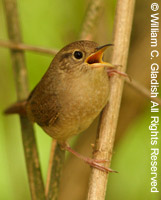 International Migratory Bird Day (IMBD), May 13, 2006 celebrated the incredible spring journeys of migratory birds - nearly 350 species of migratory birds travel between nesting habitats in North America and non-breeding grounds in South and Central America, Mexico, and the Caribbean. IMDB is one of the world's largest conservation festivals. Each year, hundreds of thousands of people observe International Migratory Bird Day, gathering in town squares, community centers, schools, parks, and refuges across the Western Hemisphere to learn more about wild birds, take action to conserve birds and their habitats, and simply have fun. International Migratory Bird Day (IMBD), May 13, 2006 celebrated the incredible spring journeys of migratory birds - nearly 350 species of migratory birds travel between nesting habitats in North America and non-breeding grounds in South and Central America, Mexico, and the Caribbean. IMDB is one of the world's largest conservation festivals. Each year, hundreds of thousands of people observe International Migratory Bird Day, gathering in town squares, community centers, schools, parks, and refuges across the Western Hemisphere to learn more about wild birds, take action to conserve birds and their habitats, and simply have fun.The theme of the 2006 International Migratory Bird Day was North America's Boreal Forest, the "Bird Nursery of the North". The Boreal Forest represents 26% of the land area of the US and Canada, yet it supports nearly 50% of North America's bird species. While highlighting the beauty of Canada's Boreal forests, wetlands and waters, and its importance to migratory birds, the hundreds of events and activities related to International Migratory Bird Day also addressed factors impacting Canada's Boreal region and provide numerous ways for the public to become involved in Boreal region conservation. Visit the International Migratory Bird Day web site Visit the Boreal Songbird Initiative web site View the May 12, 2006 Canadian Boreal Initiative press release Sources: Canadian Boreal Initiative, International Migratory Bird Day, Boreal Songbird Initiative |
|
| Biodiversity Loss Increasing - IUCN | 16 May 06 |
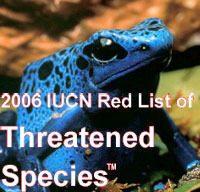 The World Conservation Union (IUCN) has released the 2006 IUCN Red List of Threatened Species. Too big to publish as a book, the Red List is a searchable database that describes the status of more than 40,000 species most in need of conservation attention. The World Conservation Union (IUCN) has released the 2006 IUCN Red List of Threatened Species. Too big to publish as a book, the Red List is a searchable database that describes the status of more than 40,000 species most in need of conservation attention.As of 2006, more than 16,000 species of animals, birds, fish and plants are registered as under serious threat of becoming extinct. The 2006 Red List indicates a clear trend - biodiversity loss is increasing. The IUCN Red List is widely recognized as the most authoritative assessment of the global status of plants and animals. Polar bears were previously listed by IUCN as a 'conservation dependent' species, but with the 2006 Red List assessment, the polar bear moves into the threatened categories and has been classified as 'vulnerable'. Dependent upon Arctic ice-floes for hunting seals and highly specialized for life in the Arctic marine environment, polar bears are predicted to suffer more than a 30% population decline in the next 45 years. View the May 2, 2006 IUCN press release View the IUCN Red List online searchable database View the May 2, 2006 Ottawa Citizen article (DOC) View the May 1, 2006 Times (UK) article Sources: IUCN, Ottawa Citizen, Times UK |
|
| Wildlands League Releases Boreal 'Portrait' | 16 May 06 |
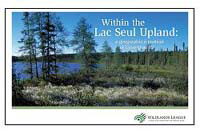 CPAWS Wildlands League in Ontario recently released a geographical 'portrait' of one of the province's northern boreal Ecoregions. The portrait inventories many ecological and cultural values of Ontario's northern boreal forest and includes maps that reveal the location of a range of features, from intact forests and watersheds to road corridors and potential hydro transmission corridors. CPAWS Wildlands League in Ontario recently released a geographical 'portrait' of one of the province's northern boreal Ecoregions. The portrait inventories many ecological and cultural values of Ontario's northern boreal forest and includes maps that reveal the location of a range of features, from intact forests and watersheds to road corridors and potential hydro transmission corridors.Ecoregion 3S lies within the heart of Canada's boreal region and consists of a largely unbroken band of forests, wetlands, lakes and rivers that extends from the Manitoba border in the west to Wabakimi Provincial Park in the east. The boreal portrait conveys the ecological importance of the region, the values at stake should development proceed, and the unique characteristics of this landscape. This important work by the Wildlands League is publicly available and could be used by communities as part of the foundation for conservation planning in Ecoregion 3S. View Within the Lac Seul Upland: a geographical portrait of Ecoregion 3S (PDF) Visit the CPAWS Wildlands League web page on the Ecoregion 3S portrait Source: CPAWS Wildlands League |
|
| Accountability Act Blocks Access to Information | 12 May 06 |
 Prime Minister Stephen Harper has done a complete about-face, introducing plans that would increase government secrecy after campaigning on openness, says Canada's information czar. "All of the positions the government now takes in the discussion paper are contrary to the positions the Conservative Party took, and its leader espoused, during the election campaign," wrote Information Commissioner John Reid. Prime Minister Stephen Harper has done a complete about-face, introducing plans that would increase government secrecy after campaigning on openness, says Canada's information czar. "All of the positions the government now takes in the discussion paper are contrary to the positions the Conservative Party took, and its leader espoused, during the election campaign," wrote Information Commissioner John Reid.In a special report to Canada's Parliament, Reid said no government has ever put forward "a more retrograde and dangerous" set of proposals to change the Access to Information Act since the legislation first came into effect in 1983. Reid has charged that the proposed Accountability Act, now being debated in the House of Commons, will make it easier for the government to: cover up wrongdoing; shield itself from embarrassment; and increase control over the flow of information to Canadians. Among the proposed changes to the Access to Information Act in the Accountability Act:
View the April 29, 2006 National Post article View the April 28, 2006 Toronto Star article Sources: Ottawa Citizen, National Post, Globe and Mail, Toronto Star |
|


 RSS Feeds:
RSS Feeds: